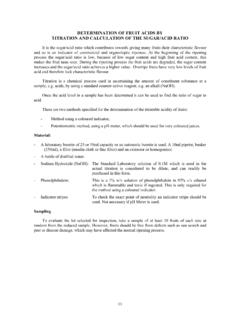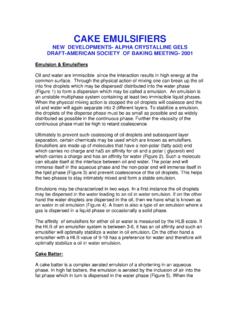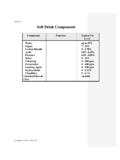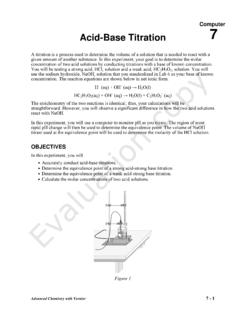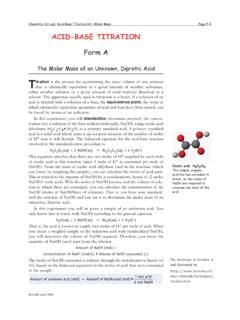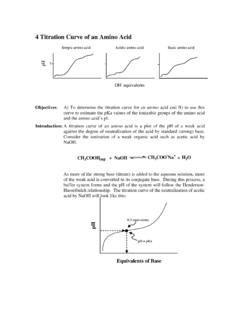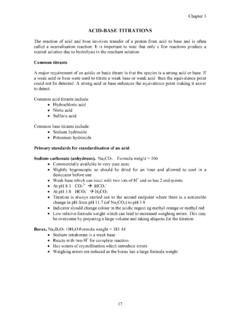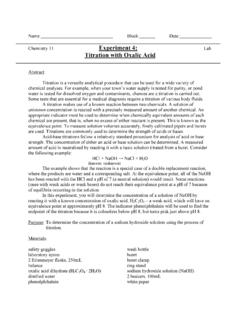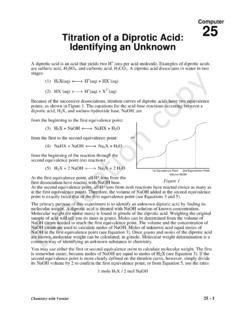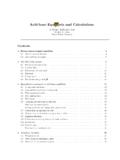Transcription of TITRATION OF A COLA PRODUCT - Fantastic Flavours
1 1 ExperimentTITRATION OF A cola PRODUCTThe CCLI InitiativeComputers in Chemistry Laboratory InstructionLEARNING OBJECTIVESThe objective of this laboratory experiment is to determine the molar concentration of phosphoric acid in acola is an analytical technique used to find the concentration of a known volume of unknown substanceby adding a known concentration of a known substance. As the unknown and known substance react, welook for a "telltale" indication that the reaction is complete, which allows us to determine the concentrationof the most common type of TITRATION is known as an acid-base TITRATION . In an acid-base TITRATION , we startwith a known amount (usually a volume) of an unknown concentration of acid and add to it known amountsof a known concentration of base (or vice versa).For our purposes, the equivalence point is the most crucial point in the TITRATION . It is the point during thetitration where the moles of base added will equal the moles of acid in the unknown solution (or vice versa).
2 Since the volume of base added can be read from the buret at this point and the concentration of the base andthe volume of the acid are also known, the concentration of the unknown acid solution can be are a number of ways to determine the equivalence point, two of which can be used in this first is by measuring the pH of the solution as you add base to the acid. There is a dramatic increase inthe pH of the solution at the equivalence point(s) as shown in Figure 1 on the following page. A second wayto detect the equivalence point is by using a thermometric method. Because acid-base reactions areexothermic, the solution being titrated warms as base is added. At the equivalence point, there is no furtheracid-base neutralization reaction and solution warming decreases or ceases abruptly. If you have a preciseenough temperature measuring device, this abrupt change in the heating curve can be acid content of many foods and beverages contribute significantly to the taste.
3 Soft drinks often containvarying quantities of several acids. In cola products, these acids are predominantly carbonic acid (from thecarbonated water) and phosphoric acid. By decarbonating the cola , you can determine the phosphoric acidconcentration via TITRATION . The phosphoric acid content is usually quite low, so good technique is acid is a weak acid. It is also a polyprotic acid, which means it will liberate more than one proton(H) in solution. Phosphoric acid reacts with NaOH in the following manner:+34(aq) (aq)24(aq) 2(l)HPO+ OH==>HPO + HO(1)!!24(aq) (aq) 4(aq) 2(l)HPO + OH ==>HPOHO(2)+ !!2!4(aq) (aq) 4(aq) 2(l)HPO + OH ==>PO + HO(3)2!!3!Each of the above reactions will have its own equivalence point.
4 However, because of the concentration ofthe base used for the TITRATION , you can only see the equivalence points for reactions (1) and (2). The overalltitration curve will look similar to Figure only equivalence point of concern here is the first one, since it will give you the concentration of PRECAUTIONSYou must wear lab goggles at all times. If the acid or base solutions get on your skin, rinse with plenty solutions resulting from the titrations may be discarded in the sinks. Any unused base solution shouldnot be returned to the storage containers; therefore, take only the quantities of solution that you will PERFORMING THIS EXPERIMENT .. you will need a MicroLAB program capable of measuring pH and/or temperature with respect to thevolume of titrant. This volume may be a time, a drop count, or a manually-input volume reading from theburet. Your instructor will indicate which of the pH-temperature programs you are to PROCEDURESYour TITRATION set-up will look similar to that shown in Figure 2.
5 Before using the pH electrode and/ortemperature probe, they must be calibrated. Consult your instructor regarding the procedure to should obtain temperature and/or pH, and volume data for at least 10 ml beyond the equivalence should stir the solution with a stirring rod or magnetic stirrer at all times, leaving the thermistor and/orpH electrode stationary in the Styrofoam cup. You will observe the TITRATION curve forming on the graph asyou carry out the TITRATION . If you use a drop counter, you will need to Calibrate the drops per ml, using theDrop Counter Calibration provided by your instructor to convert drops into volume. Your instructor willindicate which one you are to about 75 ml of cola into a clean, dry 250 ml beaker. To prepare the cola for TITRATION , it must firstbe decarbonated. Cover the beaker containing the cola with a watch glass and gently boil for about 20minutes using a Bunsen burner or a hot plate. This will remove the carbon dioxide from the cola , whichwould interfere with the phosphoric acid TITRATION .
6 Let the cola cool to room temperature a pipet, add ml of room temperature, decarbonated cola into a clean, double-nestedStyrofoam 1. TITRATION curve for phosphoric acid from 2. Set-up for the MicroLAB interface a 250 ml beaker, obtainabout 55 ml of M the exact concentration ofthe NaOH from the prepare the buret for thetitration, it should first be rinsedwith deionized water and thenrinsed with several smallportions of the NaOH begin the TITRATION , the buretshould contain between 40 and50 ml of instructor will inform youconcerning which procedure youwill use to carry out should conduct at least threetitrations of the cola in order todetermine your the graphically-obtainedpH and/or thermometric firstequivalence the MicroLAB Hand Enter mode enter the equivalence point volumes for the three best34titrations, and using the Add Formula function, set up a formula to calculate the moles of HPOin each of the ml samples of cola .
7 Your instructor may want you to use the first derivative toobtain the equivalence point volume, then click-drag the formula to Column using the Add Formula function, set up a formula to calculate the molarity of HPO in thecola for each sample, then click-drag the formula to Column the Statistics window by right-clicking on Column D, and determine the average andstandard deviation for your molarity your report, print out the graphs for the three best titrations , the spreadsheet for the Hand Entereddata, and the Statistics

